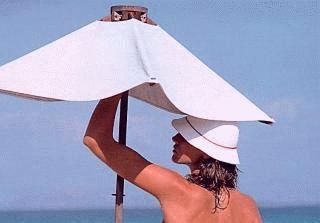SUN SAFETY
SUN SAFETY:
BE SUN SAFE
AND SENSIBLE!

|
From the  ' Series on . . .
' Series on . . .
BE SUN SAFE!
 Catch the rays before they catch you.
Catch the rays before they catch you.
 When at the beach, where the general idea is to take off most of your clothes, be conscious of how much time you are exposing your skin to the sun. Exposure to ultraviolet rays is cumulative over the years; eventually it can give you a leathery look and lead to skin cancer.
When at the beach, where the general idea is to take off most of your clothes, be conscious of how much time you are exposing your skin to the sun. Exposure to ultraviolet rays is cumulative over the years; eventually it can give you a leathery look and lead to skin cancer.
 Beach visitors who are not used to it, and especially those with fair skin, should use sunblock cream or lotion with a sun protective factor (SPF) of at least 15, or maybe even 21 or higher. Apply it at the beginning. Don't wait until the day is half over or until your skin starts feeling hot or looking pink; by then it will be too late. The sun's rays are most intense between 10 a.m. and 2 p.m., Especially during the hot summer months.
Beach visitors who are not used to it, and especially those with fair skin, should use sunblock cream or lotion with a sun protective factor (SPF) of at least 15, or maybe even 21 or higher. Apply it at the beginning. Don't wait until the day is half over or until your skin starts feeling hot or looking pink; by then it will be too late. The sun's rays are most intense between 10 a.m. and 2 p.m., Especially during the hot summer months.
[ Please Note: The Amercan Academy of Dermatology now recommends that you limit your exposure to the sun between the hours of 10 a.m. and 4 p.m.
Please Note: The Amercan Academy of Dermatology now recommends that you limit your exposure to the sun between the hours of 10 a.m. and 4 p.m.
 Ultraviolet rays, the ones that do damage, go right through clouds, so it is possible to get sunburned even on overcast days. Water is reflective, bouncing UV rays up to zap you on undersides you think are shaded. Apply some of that protective lotion under your nose, as well as on top of it.
Ultraviolet rays, the ones that do damage, go right through clouds, so it is possible to get sunburned even on overcast days. Water is reflective, bouncing UV rays up to zap you on undersides you think are shaded. Apply some of that protective lotion under your nose, as well as on top of it.
Copyright © 1995, Los Angeles Times.
Used With Permission.
 A Very Special Note, Protect Your Beach Baby
A Very Special Note, Protect Your Beach Baby
Babies under one (1) year of age should stay out of the sun. Use lightweight, light-colored clothing. Always cover a baby's head with a hat that has a wide brim. Only ever use a low level sunblock (around 4 SPF - Sun Protection Factor) as an infant's skin is sensitive and system may not be able to "flush out" chemicals absorbed through the skin.

Parents PROTECT Yourself and Your Children From the Sun With These
SUN SAFETY TIPS
 Stay Away from the midday sun - especially from 10 a.m. to 4 p.m. - when the sun's rays are the strongest.
Stay Away from the midday sun - especially from 10 a.m. to 4 p.m. - when the sun's rays are the strongest.
 To Block the sun apply sunscreen with a Sun Protection Factor (SPF) of at least 15 about 20 minutes before sun exposure. Reapply every two hours and after swimming and sweating. Apply sunscreen beginning at 6 months of age.
To Block the sun apply sunscreen with a Sun Protection Factor (SPF) of at least 15 about 20 minutes before sun exposure. Reapply every two hours and after swimming and sweating. Apply sunscreen beginning at 6 months of age.
 Cover up with a wide-brim hat or visor, tightly woven clothing and sunglasses when outdoors.
Cover up with a wide-brim hat or visor, tightly woven clothing and sunglasses when outdoors.
 Shade - Keep infants under 6 months of age out of direct sunlight and in the shade. Use an umbrella over the stroller.
Shade - Keep infants under 6 months of age out of direct sunlight and in the shade. Use an umbrella over the stroller.
- From the Good Doctors of the American Academy of Dermatology & American Academy of Pediatrics
 Sun Tan Lotions,
Sun Tan Lotions,
Creams and
Sunblocks:

- Should Be Used Whenever You're in the Sun
- Should Have a Sun Protection Factor (SPF) of 15 or Above
(Many of Our Lifeguards Use 30+ SPF.) - Should Be Broad Spectrum - Block UVA and UVB Rays
- Should Be Applied Early
- Should Be Re-Applied At Least Every Two (2) Hours
- Should Be Applied Even When It's Cloudy
- Should Be Used Only To Protect -- Are NOT a License To Tan
- Should Always Be Used on Keiki (Children)!
- Should be up-to-date. Check the date on your sunscreen. If itâs expired, the active ingredients may no longer absorb UV light.
From the July 9, 1996 ... 
Science Questions and Answers
By C. CLAIBORNE RAY
![]() . What does an S.P.F. rating mean on my suntan lotion?
. What does an S.P.F. rating mean on my suntan lotion?
. The letters S.P.F. stands for sun protection factor, but dermatologists wish people didn't think the numbers offered a license to tan.
 A factor is a number used to multiply another number, in this case your time in the sun before burning. An S.P.F. of 2 means that if you usually start to burn in 20 minutes, using the product would, in a perfect world, let you bask twice as long before you burn, assuming that the product is fresh and full strength, that you apply enough (at least an ounce) and that you don't swim or sweat it off.
A factor is a number used to multiply another number, in this case your time in the sun before burning. An S.P.F. of 2 means that if you usually start to burn in 20 minutes, using the product would, in a perfect world, let you bask twice as long before you burn, assuming that the product is fresh and full strength, that you apply enough (at least an ounce) and that you don't swim or sweat it off.
 The almost universal medical advice is to talk about sunscreen or sunblock, not suntan and certainly not sunburn. And almost universally, dermatologists say an S.P.F. of 15 is what you routinely need to help you protect your skin just from burns.
The almost universal medical advice is to talk about sunscreen or sunblock, not suntan and certainly not sunburn. And almost universally, dermatologists say an S.P.F. of 15 is what you routinely need to help you protect your skin just from burns.
 And a burn is just the tip of the iceberg. The S.P.F. estimates only the amount of protection provided against ultraviolet-B rays, the so-called burning rays, which attack the skin surface, while insidious damage is done by the deeply-penetrating UVA rays, which destroy the skin's support structure. Some products will cut down both kinds.
And a burn is just the tip of the iceberg. The S.P.F. estimates only the amount of protection provided against ultraviolet-B rays, the so-called burning rays, which attack the skin surface, while insidious damage is done by the deeply-penetrating UVA rays, which destroy the skin's support structure. Some products will cut down both kinds.
 The S.P.F. number dates from 1978, when the Food and Drug Administration proposed that manufacturers label sun-care products with codes from 2 to 15, based on how long they would multiply time in the sun before burning. Until 1986, the highest S.P.F. available was 20. New technology has made the top number of 1978 virtually the bottom number for cautious outdoors people of 1996, though higher and higher S.P.F.'s provide smaller and smaller increases in protection.
The S.P.F. number dates from 1978, when the Food and Drug Administration proposed that manufacturers label sun-care products with codes from 2 to 15, based on how long they would multiply time in the sun before burning. Until 1986, the highest S.P.F. available was 20. New technology has made the top number of 1978 virtually the bottom number for cautious outdoors people of 1996, though higher and higher S.P.F.'s provide smaller and smaller increases in protection.
Readers are invited to submit questions about science to Questions, Science Times, The New York Times, 229 West 43d Street, New York, N.Y. 10036.
Copyright © 1996 The New York Times Company.
Used With Permission.
Daily Ultraviolet (UV) Forecast:

Click Here To Go To the Latest UV Index For Honolulu (and Other U. S. Cities)
Click Here For Detailed Information About And On How To Use The Index
![]() Click Here to Visit the Environmental Protection Agency's Informative and Instructive Site on the UV Index
Click Here to Visit the Environmental Protection Agency's Informative and Instructive Site on the UV Index
And, . . . Always Be Sure To Wear Your Sunglasses!
 The American Academy of Ophthalmology offers the following guidelines when shopping for sunglasses:
The American Academy of Ophthalmology offers the following guidelines when shopping for sunglasses:
 Choose glasses labelled to block 99-100% UV-A and UV-B light. UV, or ultraviolet, radiation in sunlight is linked to eye disease. Price has no bearing on UV light protection.
Choose glasses labelled to block 99-100% UV-A and UV-B light. UV, or ultraviolet, radiation in sunlight is linked to eye disease. Price has no bearing on UV light protection.- UV light protection comes from a chemical coating applied to the lens, not from the color or darkness of the lens.
- Polarized lenses cut reflected glare and are useful for driving and fishing. Polarization has nothing to do with UV light protection, although many are now combined with a UV-light blocking substance.
 Large-framed wraparound sunglasses can protect your eyes from all angles, as opposed to ordinary eyeglass frames that may allow light to enter.
Large-framed wraparound sunglasses can protect your eyes from all angles, as opposed to ordinary eyeglass frames that may allow light to enter.- Even if you wear contacts with UV protection, remember your sunglasses.
 In addition to the damage caused by a lifetime of exposure to bright sun, you need to protect your eyes from acute damage caused by single outings on very bright days. Excessive exposure to ultraviolet light reflected off sand or pavement can damage the cornea, the eye's surface. Similar to a sunburn on your skin, corneal ultraviolet injuries are painful, but usually heal quickly.
In addition to the damage caused by a lifetime of exposure to bright sun, you need to protect your eyes from acute damage caused by single outings on very bright days. Excessive exposure to ultraviolet light reflected off sand or pavement can damage the cornea, the eye's surface. Similar to a sunburn on your skin, corneal ultraviolet injuries are painful, but usually heal quickly.
And . . .
- . . . ophthalmologists recommend that you wear

 99-100% UV-absorbent sunglasses and a broad-rimmed hat whenever you're in the sun long enough to get a suntan or a sunburn. Don't be fooled by a cloudy day. The sun's rays can pass through the haze and thin clouds.
99-100% UV-absorbent sunglasses and a broad-rimmed hat whenever you're in the sun long enough to get a suntan or a sunburn. Don't be fooled by a cloudy day. The sun's rays can pass through the haze and thin clouds.

